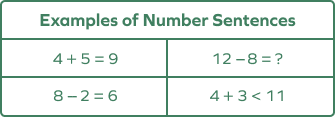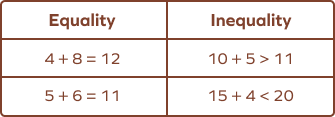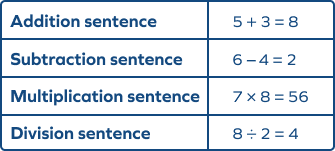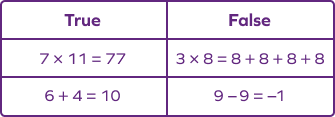JOIN OUR WHATSAPP GROUP. CLICK HERE
How to Teach Number Sentences to Grade 5 Learners
How to Teach Number Sentences to Grade 5 Learners
A number sentence is a mathematical sentence made up of numbers and symbols, as shown below.

The term “number sentence” is introduced at the elementary school level. However, the application of these sentences extends beyond elementary school because it includes equations and inequalities. These sentences can also be described as the language of mathematics. As shown below, a sentence combines two expressions with a relational symbol
.

These sentences show the equality or inequality relations using different mathematical operations like addition, subtraction, multiplication, and division.

The sign of equality and inequality is significant as the sentence is incomplete and makes no sense without them.
, is an example of a number sentence. However, if we write
, it does not make any sense.
A math sentence can be true or false depending on the information provided.
A mathematical sentence that gives all the information and is known to be either true or false, as shown in the example below.

When will my child learn about number sentences?
In the National Curriculum, number sentences are referred to as ‘mathematical statements’ – these are introduced from Year 1, where pupils read, write and interpret mathematical statements involving addition (+), subtraction (–) and equals (=) signs.
Number sentences build on what children will have already learnt about number bonds.
Year 2 pupils calculate mathematical statements for multiplication and division within the multiplication tables and write them using the multiplication (×), division (÷) and equals (=) signs.
Year 3 pupils write and calculate mathematical statements for multiplication and division using the multiplication tables that they know, including for two-digit numbers times one-digit numbers, using mental and progressing to formal written methods.
These pupils continue to practise their mental recall of multiplication tables when they are calculating mathematical statements in order to improve fluency.
Video: Number Sentences For Kids: Learn English
Number sentences can be simple or complex and can include multiple operations and variables. They are used in a wide range of mathematical concepts and are essential for solving problems and representing mathematical relationships. The concepts of number sentences are introduced in the early grades and are built upon in later years to develop more complex mathematical thinking and problem-solving skills.
Tips on how to teach number sentences to Grade 5 learners:
Teaching number sentences to Grade 5 learners can be a fun and engaging process if you follow some effective strategies. Here are some tips on how to teach number sentences to Grade 5 learners:
- Use Visual Aids: Use visual aids, such as number charts, number lines, and manipulatives like blocks or cubes, to help students understand the concepts of addition, subtraction, multiplication, and division.
- Relate Number Sentences to Real-Life Situations: Relate number sentences to real-life situations to help students understand why they are important. For example, when teaching addition, use real-life situations like adding up the cost of groceries or adding the number of students in a class.
- Emphasize the Order of Operations: Emphasize the importance of following the order of operations when solving number sentences. Use examples and practice problems to reinforce the concept and explain why it is important.
- Use Interactive Games and Activities: Use interactive games and activities, such as online math games or hands-on math activities, to engage students and reinforce the concepts they have learned.
- Encourage Peer Learning: Encourage peer learning by having students work in pairs or small groups to solve number sentences together. This can help students build confidence, develop teamwork skills, and learn from each other.
- Provide Feedback: Provide feedback to students on their progress and encourage them to keep trying even if they make mistakes. This can help them develop a growth mindset and learn from their mistakes.
- Differentiate Instruction: Differentiate instruction to meet the needs of all learners. Provide support and additional resources to students who are struggling, and challenge advanced learners with more complex problems and activities.
In summary, teaching number sentences to Grade 5 learners involves using a range of strategies that cater to the students’ different learning styles and abilities. By using visual aids, real-life examples, interactive games, and peer learning, teachers can help students understand the concepts of addition, subtraction, multiplication, and division, and build their confidence in math.
Number Sentences Lesson Example
Objective: By the end of this lesson, students will be able to create and solve number sentences using addition, subtraction, multiplication, and division.
Introduction: Explain to the students that a number sentence is a mathematical expression that contains numbers and operations. Give examples of different number sentences, such as “3 + 5 = 8” or “6 x 2 = 12.” Ask the students to identify the operations and numbers in the examples.
Examples:
- 4 + 2 = ?
- 10 – 3 = ?
- 6 x 5 = ?
- 30 ÷ 5 = ?
Questions:
- What is a number sentence?
- What are the four basic operations in mathematics?
- Can a number sentence have more than one operation? Give an example.
- What is the order of operations in mathematics?
Answers:
- A number sentence is a mathematical expression that contains numbers and operations.
- The four basic operations in mathematics are addition, subtraction, multiplication, and division.
- Yes, a number sentence can have more than one operation. For example: “7 – 3 x 2 = 1”
- The order of operations in mathematics is Parentheses, Exponents, Multiplication and Division (from left to right), and Addition and Subtraction (from left to right).
Activity: Have the students work in pairs to create their own number sentences using the four basic operations. Once they have created their number sentences, have them solve them and check each other’s work. Encourage the students to use the order of operations to simplify their expressions.
Conclusion: Ask the students to share some of the number sentences they created and solved with the class. Emphasize the importance of using the correct order of operations and encourage the students to practice creating and solving number sentences on their own.
Number Sentences Classroom Activities Example
Number sentence activities can be a fun and engaging way to help students learn and practice their math skills. Here are some examples of number sentence activities for Grade 5 learners:
- Create a Number Sentence Book: Have students create a number sentence book by writing out different number sentences using addition, subtraction, multiplication, and division. They can illustrate the pages of the book with pictures or diagrams that represent each number sentence.
- Play Number Sentence Bingo: Create bingo cards with different number sentences, and call out the answers to the number sentences. Students can mark the answers on their bingo cards as they are called.
- Number Sentence Relay Race: Divide students into teams and have them race to complete a series of number sentences. Each student takes a turn to solve a number sentence and then passes it on to the next person until all of the number sentences have been solved.
- Number Sentence Scavenger Hunt: Create a scavenger hunt in which students have to find and solve different number sentences that are hidden throughout the classroom or school.
- Number Sentence Puzzles: Create number sentence puzzles by writing out different number sentences on puzzle pieces. Have students match the puzzle pieces to create complete number sentences.
- Calculator Challenge: Give students a set of number sentences and challenge them to solve the problems using a calculator. You can also time the activity and make it a race to see who can solve the most number sentences in a set amount of time.
- Roll and Solve: Have students roll dice to create two numbers, then write and solve a number sentence using those two numbers. They can repeat the activity with different dice combinations to practice solving different number sentences.
These are just a few examples of number sentence activities that can engage and challenge Grade 5 learners. By making math fun and interactive, students can develop a love for math and build their confidence in solving number sentences.
JOIN OUR TELEGRAM CHANNEL. CLICK HERE

Be the first to comment